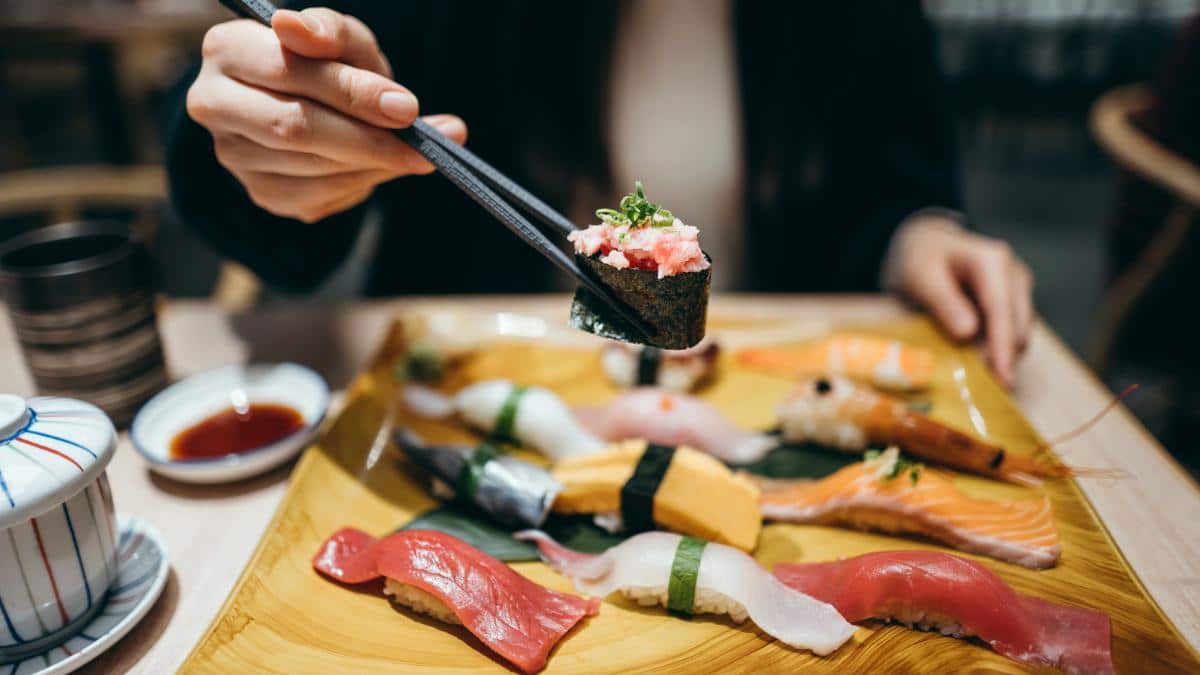
Is Your Fish Fake? Report Shows Rampant Global Seafood Fraud

A 2017 study found that half of Los Angeles sushi was not what it claimed to be. d3sign / Getty Images
How can you tell that the fish on your plate is the real thing? You can’t — and that’s the problem.
A new report in The Guardian‘s “Seascape” series on the state of the world’s oceans surveyed 44 separate studies published since 2018, and found that almost 40 percent of 9,000 seafood products from restaurants, markets and fishmongers were mislabelled. According to Food & Wine, the report detailed how rampant seafood fraud has become on a global scale.
The U.S. and Canada had the highest rates of mislabeling followed by Europe, Eat This reported. Food & Wine also highlighted how seafood fraud is not a new issue: in 2017, a study found that half of Los Angeles sushi was not what it claimed to be, while a 2018 study revealed that more than 25 percent of supermarket fish in New York was mislabeled.
“And yet, despite government action and the promise of technical solutions like detectors and databases, it’s not getting better,” Food & Wine lamented.
The studies in the Seascape report used new DNA techniques and tests to ascertain exactly what was ending up on consumers’ plates. They found fish substitutions from the same family, such as low-grade tuna species, being sold as higher-valued species, such as bluefin. The lower-value, lower-quality substitutions point to fraud more than error, the report suggested.
There are “so many opportunities along the seafood supply chain” to falsely label low-value fish as high-value species, or farmed fish as wild,” Beth Lowell, deputy vice-president for U.S. campaigns at Oceana, told The Guardian. She noted that all the studies found mislabeling in the global seafood industry to be common and pervasive.
There were also substitutions for entirely different species, including Singaporean prawn balls that repeatedly tested negative for containing prawn DNA, and were instead made almost entirely of pork, Seafood Harvest reported. Other mixed seafood products turned out to be similarly mislabeled.
Among the most alarming substitutions were rare and endangered species being marketed otherwise. One study found that 70 percent of UK snapper instead consisted of 38 different species of fish, many of them critical reef-dwellers, The Guardian reported. This deceptive swapping is a problem for coral reefs that already suffer from overfishing of key fish species that eat algae and allow for a healthier ecosystem, The Guardian added.
The final mislabeling category that the Seascape report highlighted involves laundering illegally caught fish. Rashid Sumaila, a fisheries economist, explained to The Guardian how fish laundering is often linked to illegal, unreported and unregulated (IUU) fishing that threatens the sustainability of many fish stocks worldwide. Oceana‘s examples of IUU fishing include fishing without authorization, ignoring catch limits, operating in closed areas, targeting protected wildlife and fishing with prohibited gear. Then, too often, illegal and legal catches are commingled when they are processed aboard ships with little monitoring and less transparency. This makes it nearly impossible to trace what is and isn’t illegal, let alone what comprises a specific catch. The fraud continues with relative ease and a lot of profit, Sumaila told The Guardian.
In a press statement urging President Biden to increase transparency and traceability in American seafood, Oceana called IUU fishing “one of the greatest threats to our oceans” and estimated that it costs the global seafood industry up to billion each year. In the U.S., up to 90 percent of fish consumed is imported, the statement noted. This non-transparent, foreign supply chain has allowed for a high degree of U.S. imports to come from IUU fishing, the statement claimed.
“IUU fishing is a low-risk, high-reward activity, especially on the high seas where a fragmented legal framework and lack of effective enforcement allow it to thrive,” Oceana said. The Guardian’s reporting also found the complex and opaque seafood supply chains to be highly vulnerable to mislabeling that is profitable and relatively easy to execute.
Lowell said in the Oceana statement, “Americans have a right to know more about the seafood they eat and should have confidence that their dollars are not supporting the pillaging of the oceans or human rights abuses at sea.” She concluded that, “All seafood sold in the U.S. should be safe, legally caught, responsibly sourced and honestly labeled. Until then, honest fishermen, seafood businesses, consumers and the oceans will pay the price.”
Still, some in the industry have hope. In another article by The Guardian, Organic Ocean Seafood in Vancouver, Canada, was singled out for its DNA testing. Dane Chauvel, the company’s co-founder, uses e-DNA testing to fight seafood fraud. Chauvel supplies many high-end restaurants with wild-caught salmon and other gourmet fish, and can prove that his fish supply is legitimate thanks to the world’s first random DNA testing program for authentication. This removes any lingering doubt about its origins for his top-end clients, Chauvel said. The test can even identify the origin river of a specific fish sample.
Generally, “The fishing industry is a mess,” Chauvel admitted to The Guardian. “It’s dysfunctional.” He urged others to follow his lead and voluntarily submit their products for testing and authentication. It would be even better if regulatory agencies followed suit, he added. Chauvel told The Guardian, “I hope using DNA testing becomes more commonplace in the industry. It’s been a great business advantage for us.”
- 5 Ways Sustainable Seafood Can Benefit People and the ...
- Can We Enjoy Meat and Seafood and Save the Planet? - EcoWatch
- Seafood Study Finds Plastic in 100% of Samples - EcoWatch
- Who’s to Blame for the Lawbreaking and Habitat Destruction in U.S. Fisheries?
- Three Sustainable Seafood Brands to Know for World Oceans Day
- Marine Protected Areas Are Less Effective Than We Thought — Illegal Fishing Is to Blame

 233k
233k  41k
41k  Subscribe
Subscribe 